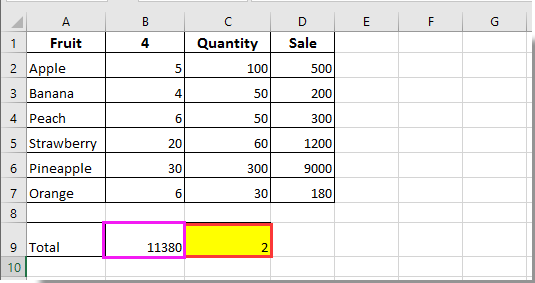Jak policzyć, ile razy komórka została zmieniona w programie Excel?
Aby policzyć, ile razy określona komórka została zmieniona w programie Excel, pomocne mogą być kody VBA podane w tym artykule.
Policz, ile razy komórka została zmieniona za pomocą kodu VBA
Policz, ile razy komórka została zmieniona za pomocą kodu VBA
Poniższe kody VBA mogą pomóc w policzeniu, ile razy określona komórka została zmieniona w programie Excel.
1. W arkuszu zawierającym jedną lub więcej komórek, dla których musisz obliczyć całkowitą zmianę, kliknij prawym przyciskiem myszy kartę arkusza, a następnie kliknij Wyświetl kod z menu kontekstowego. Zobacz zrzut ekranu:

2. W otwarciu Microsoft Visual Basic for Applications okno, skopiuj i wklej jeden z następujących kodów VBA do Code okno według Twoich potrzeb.
Kod VBA 1: Śledź zmiany tylko w jednej komórce
Dim xCount As Integer
Private Sub Worksheet_Change(ByVal Target As Range)
Dim xRg As Range, xCell As Range
On Error Resume Next
If Target = Range("B9") Then
xCount = xCount + 1
Range("C9").Value = xCount
End If
Application.EnableEvents = False
Set xRg = Application.Intersect(Target.Dependents, Me.Range("B9"))
If Not xRg Is Nothing Then
xCount = xCount + 1
Range("C9").Value = xCount
End If
Application.EnableEvents = True
End SubNote: W kodzie B9 to komórka, którą musisz policzyć jej zmiany, a C9 to komórka, która zapełni wynik zliczania. Zmień je według potrzeb.
Kod VBA 2: Śledź zmiany w wielu komórkach w kolumnie
Private Sub Worksheet_Change(ByVal Target As Range)
'Updated by Extendoffice 20220916
Dim xSRg As Range
Dim xRRg As Range
Set xSRg = Range("B9:B1000")
Set xCell = Intersect(xSRg, Target)
If xCell Is Nothing Then Exit Sub
Application.EnableEvents = False
On Error Resume Next
Set xCell = xCell.Range("A1")
Set xRRg = xCell.Offset(0, 1)
xRRg.Value = xRRg.Value + 1
Application.EnableEvents = True
End SubNote: W tej linii "Ustaw xRRg = xCell.Offset(0, 1)", numer 1 reprezentuje liczbę kolumn do przesunięcia na prawo od odniesienia początkowego (tu odniesienie początkowe to kolumna B, a liczba, którą chcesz zwrócić, jest w kolumnie C który znajduje się obok kolumny B). Jeśli chcesz wyprowadzić wyniki w kolumnie S, zmień numer 1 do 10.
Odtąd, gdy zmieni się komórka B9 lub dowolna komórka z zakresu B9:B1000, całkowita liczba zmian zostanie nałożona i automatycznie wypełniona w określonej komórce.

Najlepsze narzędzia biurowe
Zwiększ swoje umiejętności Excela dzięki Kutools for Excel i doświadcz wydajności jak nigdy dotąd. Kutools dla programu Excel oferuje ponad 300 zaawansowanych funkcji zwiększających produktywność i oszczędzających czas. Kliknij tutaj, aby uzyskać funkcję, której najbardziej potrzebujesz...

Karta Office wprowadza interfejs z zakładkami do pakietu Office i znacznie ułatwia pracę
- Włącz edycję i czytanie na kartach w programach Word, Excel, PowerPoint, Publisher, Access, Visio i Project.
- Otwieraj i twórz wiele dokumentów w nowych kartach tego samego okna, a nie w nowych oknach.
- Zwiększa produktywność o 50% i redukuje setki kliknięć myszką każdego dnia!
